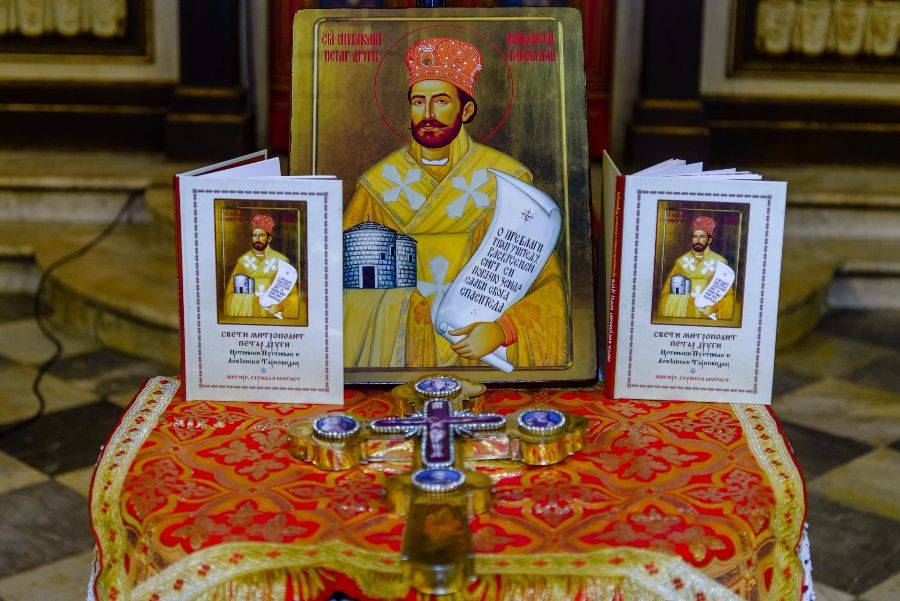
Metropolitan and Lovćen
The current public quarrels about the "renovation of Njegoš's chapel on Lovćen" have redundant and unhealthy negative tones. On the one hand, such a topic seems like a meteor that will burn Montenegro, and its proponents look like, if not aliens, then at least non-Montenegros (non-Earthlings). Others, I would say, want to use this topic to move the citizens of Montenegro to thinking, questioning, public discussion and possible reconciliation. Which sounds more fantastic to you?
In a picturesque place near the Adriatic coast, there is a church-tomb where a great South Slavic artist is buried. He was a declared Christian, but with his work of genius, he sometimes went beyond the scope of church canons and expected forms. And yet, in addition to his colorful creative work, remaining a believer deep in his soul, he wanted to be buried in the church, where he still rests today. If you think I'm talking about Njegoš, you're wrong. It is about Ivan Meštrović and the Church of the Holy Redeemer in Dalmatia's Petrovo Polje, the birthplace of the Meštrović family. Although original, with pronounced elements of syncretism, this is a Roman Catholic place of worship in which, according to the artist's votive wish, "vernacular mass is regularly celebrated". Njegoš also had a similar artistic path, and the same dying wish, but it was canceled and stolen from him, due to a complex of troubling historical circumstances. The late master Ivan himself participated in that robbery (it is impossible that he did not hear or know about the opposition of so many artists to the project that was commissioned to him), but his responsibility is minimal and indirect. It's our fault...
The current public arguments about the "renovation of Njegoš's chapel in Lovcen" have redundant and unhealthy negative tones. On the one hand, such a topic seems like a meteor that will burn Montenegro, and its proponents look like, if not aliens, then at least non-Montenegros (non-Earthlings). Others, I would say, want to use this topic to move the citizens of Montenegro to thinking, questioning, public discussion and possible reconciliation. Which sounds more fantastic to you? A deadly meteor sent by aliens? Or reconciliation? To me personally, the latter sounds noble, no matter how unrealistic it may seem ("And dreams are usually worth it, only when they grow old with you... When they grow old with you..." Đ. Balašević). My small contribution to the attempt to turn the fighting and shouting into dialogue is this: the initiative to rebuild the chapel is not new. It has literally been going on since its demolition in 1972, and it was preceded by a wide public discussion against the construction of the mausoleum, and a rather "deaf" attitude of the then authorities towards the statements of that polemic. Basically, 12 years ago, on June 25, 2012. Metropolitan Amfilohije of Montenegro and the Littoral wrote to the then Prime Minister of Montenegro Mr. Igor Lukšić. In that metropolitan letter, among other things, the following facts stand out:
A) In 1845, according to the testimony of M. Medaković, Njegoš's secretary, and Vuk Popović, a priest from Boka, Njegoš's contemporary, as well as indirect testimonies of LJ. Nenadović, I. Sekulić and J. Kovaljevski, Bishop Rada was involved in the construction of the church on Lovćen, and the regular worship service in it. He personally laid the foundation stone for the church, and left a bequest that he be buried in it, under the threat of damnation if this is not done. I see no other and better reason, than the authenticity of all these testimonies, why the Montenegrins, with a special ceremony and the personal presence of Prince Danilo and Princess Darinka, did exactly that in 1855. Namely, in the days after Njegoš's death, a big storm did not allow to go to Lovćen, so Petar the Second was temporarily buried in the Monastery, until 1855. If it was not Njegoš's express wish, sealed with the threat of a curse, exactly as reported by numerous chroniclers and contemporaries, the subsequent carrying of the metropolitan's remains to the top of the Lovcen desert, to a small church (chapel) could not be explained by anything reasonable. (For my understanding, personal upbringing and worldview, there should be a sanctified point here, after which words should not be wasted on any discussion about whether we need a chapel or not. But...)
That's why I would add: Jefto Milović will also write extensively about the construction of this Njegoš church in "Historical Records" from 1951. Namely, in the State Archives in Zadar, he came across a wealth of documents from the Viennese imperial administration in Dalmatia, in which he unequivocally sees how during In 1845, Njegoš builds a small church on Lovćen, with the author's great doubt as to what motives he is doing this for? In one of those reports, the district head of Kotor, Gabrijel Ivančić, assumes the following (watch out for this!!!): "It seemed that Njegoš wished that she would attract the attention of distant peoples so that they would be even more convinced of his religious feelings."
B) Austrian armed actions during 1916. damaged Njegoš's chapel so much that the responsible priest of Njegoš, parish priest of Dugodolj Đuro Pejović, act no. 9 of October 22, 1921, sent to the Cetinje Church Court, and in his capacity as a member of the Damage Assessment Commission, says that the church "if it remains in such a state, next winter it will collapse into the Koprivna Valuga" (one of the toponyms of Lovčen)!
V) Mitroolit Gavrilo Dožić requested a reception from the king and asked him to give up the intention to erect a monument-mausoleum by Ivan Meštrović on Lovćen, which the king accepted, so he redirected the intention and funds for the mausoleum to Avala so that Meštrović could erect a monument to the Unknown Hero there ( existing to this day), and all in the spirit of improving Serbian-Croatian relations in the newly formed state.
And I would add that, as far as I can understand what is documented, the original Meštrović's mausoleum, planned on the order of Karađorđević, was not devoid of religious symbolism (at least not as much as this one from 1972), it could even conditionally be considered a church similar to the one in Petrovo polje where Meštrović himself rests, - but even that was too avant-garde for the top of the SPC, which demanded a renewal with minimal deviations from Njegoš's original.
G) The testimony of the engineer Veliša Popović from Podgorica that the architect Pero Popović from Belgrade was given "a strict task that the restored church should be as identical as possible to the destroyed church, both in terms of size and appearance". And the second testimony of V. Popović that "all the stone from the old church was collected and used for the new church" as well as that "the new stone was taken from the quarry from a place called Zlatarica on Ivan's Koriti". And finally, Popović testifies that in the altar apse of the new church, an old plaque - the altar, on which the liturgy was served, both in the old and in the renovated church - was built
D) Historian Dušan Vuksan, a member of the Main Committee for the restoration of the temple and the transfer of Njegoš to Lovćen (because his earthly remains were transferred to the Cetinje monastery due to the "wounding" of the chapel in 1916), in his "Memorial to Peter the Second Petrović Njegoš, 1926" says that "the shape and size of the chapel remained the same: the new chapel was built on the foundations of the old one", only that "the space around the chapel was much expanded, built up and walled with very beautiful stone from the same type of Lovcen stone. The door is made of bronze, over it is a cross and the initials of Bishop Rad (P.P.) and two eagles".
Đ) On the Feast of Our Lady, September 21, 1925, the mortal remains of Bishop Rad were transferred and placed in a new artistic sarcophagus in the church, with the participation of Serbian Patriarch Dimitrije and sixteen archbishops of the Serbian Orthodox Church, the Czech Bishop of Gorazd, King Alexander with members of the Royal Government, representatives of the Academy and of all state, scientific, cultural and educational institutions of the then Kingdom of Serbs, Croats and Slovenes, as well as about 15,000 people gathered in Cetinje from all parts of the Kingdom.
And I would add: Not a single voice of protest is remembered or recorded, let alone any kind of barricade or any form of resistance, in Cetinje, which has been libertarian for centuries and defiant to every occupier, when it comes to this manifestation on the top of Lovcen, with the king of the Serbs in charge , Croats and Slovenes and the Serbian patriarch! Why? Well, because in the minds of the Montenegrins of that time there was no thought of any kind of occupation. The vast majority of the participants and leaders of the Christmas Rebellion later requested and received a pardon from King Alexander. Montenegrins would not have asked for pardon from the occupiers, if - as they present it to us today - they perceived Nikola's grandson as such. There has never been such resistance to the Church in Cetinje, not even on subsequent occasions when the Serbian Patriarch German visited the Cetinje Monastery (to enthrone Metropolitan Danilo Dajković) in 1961; not even in the fall of 1989. when the entire top of the Serbian Orthodox Church performs a memorial service for King Nikola, Queen Milena, and Princesses Ksenia and Vjera; neither in 1990, when Serbian Patriarch Pavle came to enthrone Metropolitan Amfilohi, nor in 1999. when Patriarch Pavle with other archbishops of the Serbian Orthodox Church came to the Cetinje monastery to rule over the current Metropolitan Ioanniki, then as vicar bishop of Budimlja (assistant to Metropolitan Amfilohi). And not only is there no resistance, but the citizens of Cetinje have been seen and chosen to participate in these festivities. When did this phenomenon of resistance (by a number of citizens) to the church leadership and attempts to disrupt worship first appear? Only in 2021. Then when previously, for the first time in history, a Montenegrin ruler was removed through elections, in a peaceful way. Who organized and who is responsible for the (apparently artificial) provoking of this resistance? Well, that deposed ruler with his various collaborators.
E) Anti-monarchist and anti-bourgeois Government of the SR of Montenegro in 1952. renews King Alexander's idea of a monument-mausoleum 30 years after the first such (or very similar) initiative of the royal house of Karađorđević.
And I add: This clearly shows that the concept and idea of a chapel as a burial place = an Orthodox place of worship is Petrović's idea, and that the mausoleum is Karađorđević's idea. It was later taken over by local communists. (As they took over the "White Palace" in Dedinje, the Palace in Bled... and many other bourgeois opulences). So, on the level of ideas: the chapel is by Petrović, and the mausoleum is by Karađorđević.
The greats of Montenegrin and Yugoslav art raised their voices against such an idea of the Montenegrin communists. In his letter, the Metropolitan singles out Petar Lubarda and Miroslav Krleža.
And I add: Rista Stijović, Meša Selimović; (I almost came across a song by Skender Kulenović in which Lovćen was sung with the chapel "No One's Own" (Tarih for Lovćen)); Miodrag Bulatović, Ivan V. Lalić, Stevan Raičković, Vasko Popa, Dušan Kostić, Mihajlo Lalić; architect and artist Aleksandar Derok; Gligor Stanojević, painter and academic Milo Milunović and many others...
At the time of its demolition, the chapel is located in the coat of arms of the SR of Montenegro; (I would add - also in the coat of arms of FK Lovćen) and it was also placed under the protection of the state, as a cultural and historical monument, registered in the Cetinje register of protected immovable cultural monuments, by decision no. 01 770/1 of July 7, 1961 by the Institute for the Protection of Cultural Monuments of Montenegro.
Ž) Metropolitan Danilo Dajković of Montenegro and the Littoral and the grandson of King Nikola, Prince Mihailo Petrović, filed a formal and legally prescribed lawsuit against the demolition of the chapel. But the opinion of self-confessed "theologian, poet and philosopher" Veljko Milatović prevailed, who, advocating for the "authenticity and originality" of Njegoš, said: "we are obliged to free the interpretation of his work, poetic and political, from the ballast of romantic and folklore naivety, Orthodox and civic mythomania..."
Z) SO Cetinje, the main bearer, by order from higher authorities, of the construction of the mausoleum and the demolition of the church, nevertheless on January 28, 1985. made the decision to build a chapel from stones thrown from Lovcen, next to the Transfiguration Church on Ivan's troughs; but since the Metropolis, for justified reasons, refused to join the Construction Commission, it was finally decided (April 12, 1985) "not to build for the time being".
I) It is about the oldest church dedicated to Saint Peter of Cetinje, so that would be a strong enough and primary reason to rebuild that church in its old place. And if it is not possible to erect it in the same place (it seems to be the atrium of the mausoleum) where Njegoš laid the foundation stone with his own hand and where it was built and restored in 1925, erect it (requested in the metropolitan's letter) in the immediate vicinity , in the space between the exit from the (monstrous) tunnel and the atrium of the mausoleum (there are two extensions, on the path towards the mausoleum, completely adequate for the size of the original Njegoš endowment, without the later (1925) added fence). Expert Committee for the Restoration of the Church of St. Peter and the fulfillment of Njegoš's will and bequest, which will be established by the Government, will restore the original church, as it was before the Austrian demolition (1916), using the experience of the great architect Nikolai Krasnov, as well as the preserved material of the destroyed church on Ivan's troughs, the altar altar - a plate from of the first church, preserved (1925) in the restored temple, as well as other elements from its interior (stored, we hope, in the Billiards and boiler room of the Cetinje municipality building). Meštrović's mausoleum remains in its place, as an expression of the spirit of its time, and of the mythomaniac interpretation of Njegoš's personality and works, with the only important difference that the earthly remains of Bishop Rad will be exhumed for the sixth time (and hopefully the last), freed from the mausoleum's basement. (=incarceration) and returned to his temple.
This letter from Amphilochius shows that, until recently, we were able to communicate on these topics in a civilized manner, and that they did not cause so much unrest among the citizens of Montenegro, as individuals want to present today. I claim that the dramatization of this topic is influenced by people who used to discuss it in a civilized manner, but in the meantime have been left without political authority and power, so they are ready to risk social stability in order not to get it all back. Namely, one year after the letter to Lukšić, exactly on the 200th anniversary of Njegoš's birth in 2013. Metropolitan Amfilohije will write to the new (old) Prime Minister Milo Đukanović. That letter begins with the words:
I remember very well that some ten years ago, when discussing the return of the Church to Lovćen, you specifically told me: "...that should be done...". Reminding you of those words, I take the opportunity to deliver to you the letter that I sent on June 25, 2012 to the then Prime Minister and the current Minister of Foreign Affairs in the Government of Montenegro, Dr. Igor Lukšić, regarding this issue.
As it is about the already published and official correspondence of two institutions, I am not "revealing America" regarding the facts on this occasion, but I remind you that, not so long ago, we talked about all this without such tensions. I have listed the important points of the metropolitan's letter to Lukšić in order to test the peaceful sleep of those who today publicly and supposedly "professionally and competently" renounce any idea of rebuilding the chapel, and who consider barbarism and indecency even the slightest attempt to discuss this, obviously complex topic, democratically and civil debates.
I am convinced that with His eternal rest, or at least with our peace of mind regarding His death, things are not as they should be. Just as I am convinced that master Ivan Meštrović rests quite pleasing to God in the Christian church of the Holy Redeemer in Dalmatia's Petrovo polje, which was built as the family chapel of this family, some half a century before the mausoleum on Lovćen. I mean, Ivan didn't remember her until the end of his earthly life, but, as an enlightened believer and a personal friend of various cardinals (I risk a note of protest from one of the neighboring countries, if I were to say by name), he knew from the beginning what the New Testament church was. /chapel, and what a granite-marble building worthy of Assyrian or Egyptian Old Testament emperors.
But those among us who did not share Njegoš's and Meštrović's spiritual beliefs did not know that, and who, against Njegoš's will, demolished the Orthodox church on Lovćen. The same one that the Austrian official from 1845, from the beginning of this text, wisely assumed was an expression of Njegoš's "religious feelings".
Archpriest-Stavrophor Gojko Perović
Source: News
PHOTOS
RELATED ARTICLES
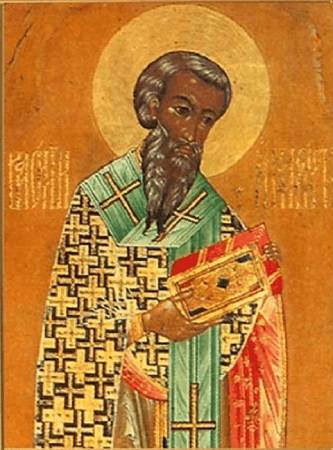
Calendar for May 9 His Homilist Basil of Amasia
Licinius, the son-in-law of Emperor Constantine, whose sister he had married,...
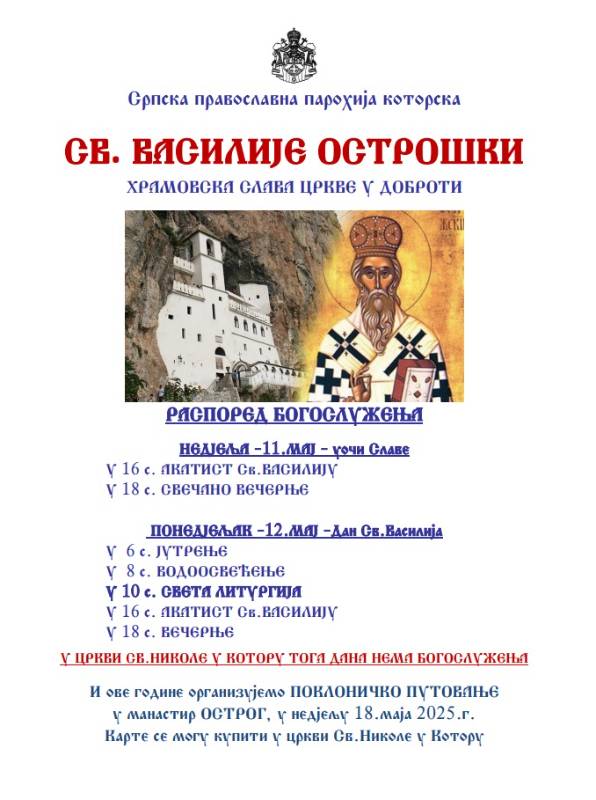
WORSHIPS ON THE OCCASION OF ST. VASILIJE OSTROŠKI
SERBIAN ORTHODOX PARISH OF KOTOR ANNOUNCES WORSHIPS ON THE OCCASION OF ST....
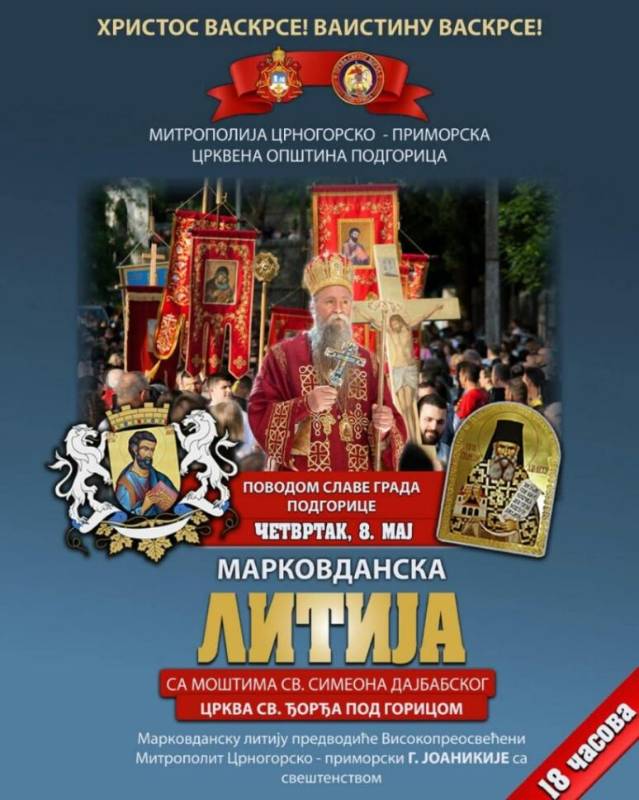
St. Mark's Day procession in Podgorica
On the occasion of the celebration of the city of Podgorica, the...


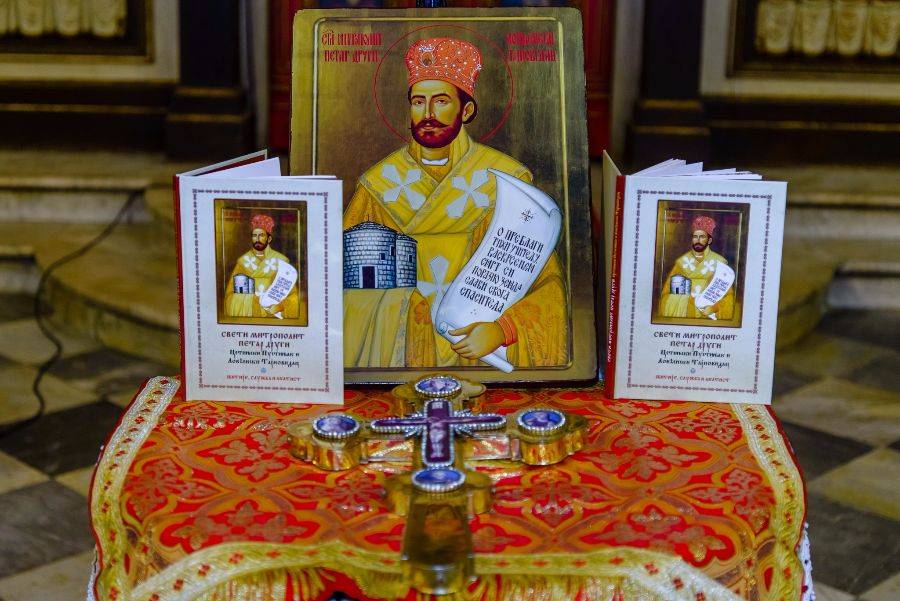

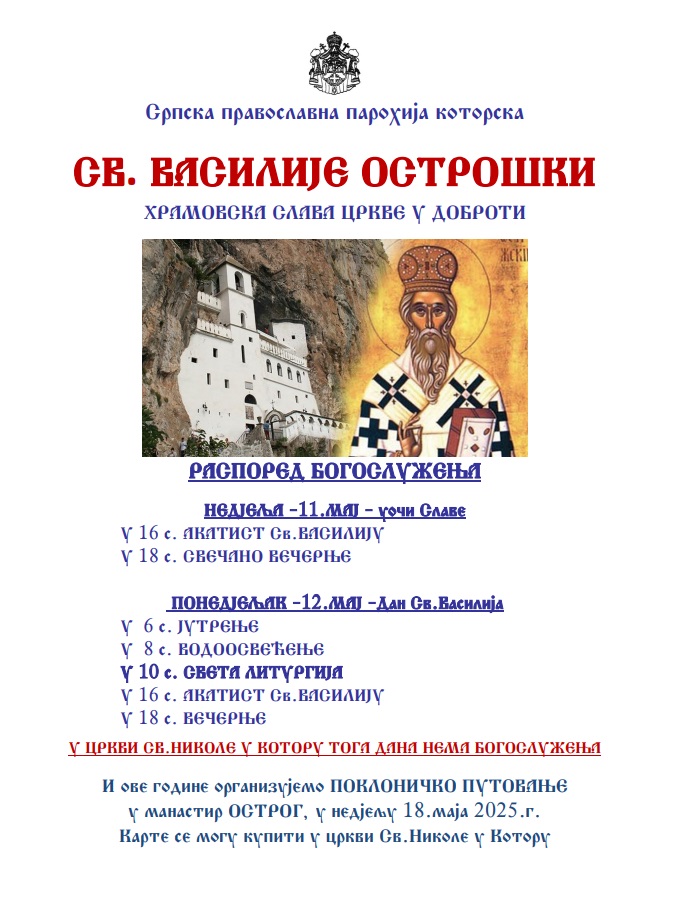
.png)